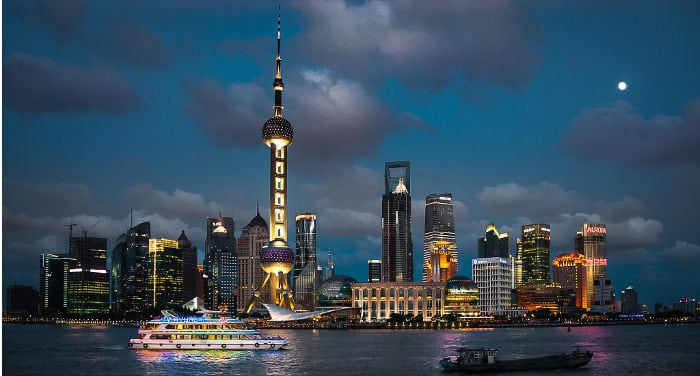
This guide is a collection of resources and practical advice for living in Shanghai.
Living and Working in Shanghai – Index
- The cost of living in Shanghai
- The Shanghai transportation system
- Shanghai weather
- Where to live in Shanghai
- Tourism in Shanghai
- Hospitals and clinics in Shanghai
- Schools and universities in Shanghai
- Shopping in Shanghai
- Addresses and useful numbers in Shanghai
- Forums and directories on Shanghai
- Frequently asked questions
The cost of living in Shanghai
Click here to read our guide on the cost of living in China.
The Shanghai transportation system
Shanghai airports
First of all, note that Shanghai is one of the cities where it’s possible to request a 144-hour visa extension.
In addition, here you’ll find our guide on international flights for China (and local flights in China).
Pudong International Airport
The main airport of Shanghai is Pudong International Airport, where the majority of intercontinental flights arrive.
The airport is located in the far east of the city; without a doubt, the easiest way to get there is to take Line 2 of the Metro (see below for more information on the Shanghai Metro) to the end (Pudong International Airport, in fact). Note that at Guanglan Road station, you’ll have to get off the Metro and take another for the final leg (even though it’s still Line 2).
You can also decide to get off at Longyang Road station and take the famous Maglev, which, with a speed of 431 Km an hour is the fastest train in the world.
Despite its speed, if you take into consideration the time you waste changing stations, buying tickets, waiting on security lines and for the train, the reality is that the time it takes to get to the airport is more or less the same as with the Metro (but the Metro costs much less and you don’t have to change stations!).
It’s also possible to get to the airport by bus. Here you’ll find the departure points of the various buses that go to the airport (they all depart from the area of Metro stations).
To close, you can also get there by taxi. The price of a trip from the city center is about 150 Yuan.
Hongqiao Airport
Shanghai also has another airport, Hongqiao Airport, situated 13 Km to the west of the city, in the Changning district.
Hongqiao Airport mostly serves domestic flights and getting there is much easier than getting to Pudong since it is in a much more “central” location. The fastest way to get to the airport is to take Metro Line 2 toward East Xujing (the same one, in the opposite direction, brings you to Pudong Airport) and get off at the Hongqiao Airport Terminal 2 stop.
You can also get to the airport by taking Line 10 of the Metro in the direction of Hongqiao Railway Station, which stops at both Terminal 1 and Terminal 2 of the airport.
Shanghai train stations
Click here to read our guide on trains in China (and to learn how to book a ticket online).
In Shanghai there are four train stations:
Shanghai Railway Station
The Shanghai Railway Station is the most important station in Shanghai. It’s located in the Zhabei district, and you can get there via lines 1, 2, and 4 of the metro (Shanghai Railway Station stop).
It is from this station that the majority of trains on the north-south route (from Beijing to Hong Kong) pass, as well as trains that go west, toward the interior of China.
Shanghai South Railway Station
Second in order of importance, Shanghai South Railway Station is found in the Xuhui district and you can get there with metro lines 1 or 3 (Shanghai South Railway Station stop).
From here the majority of trains headed toward the nearby province of Zhejiang depart along with many trains going toward the southern provinces (even though the Shanghai-Hong Kong train leaves from Shanghai Railway Station).
Shanghai Hongqiao Railway Station
The Shanghai Hongqiao Railway Station, which opened in 2010, is the most extensive train station in Asia. You can get here via Lines 2 or 10 of the Metro (Hongqiao Railway Station stop, just one stop after Terminal 2 of Hongqiao Airport, where you can also get there on foot without leaving the station).
At the moment, all trains that leave from Hongqiao station are high-speed trains (class G or D), including those for Beijing, Nanjing, Hangzhou, and the first section of the future high-speed line between Shanghai-Kunming.
Note that normal speed trains for the same destinations leave instead from Shanghai Railway Station or Shanghai South Railway Station.
Shanghai West Railway Station
The Shanghai West Railway Station is located in the Putuo district and you can get there via Metro line 11 (Shanghai West Railway Station stop).
The station, which used to be called Zhenru station, reopened in 2010 and, at the moment, only high-speed trains for Nanjing leave from there (some of which also stop at Changzhou and Suzhou).
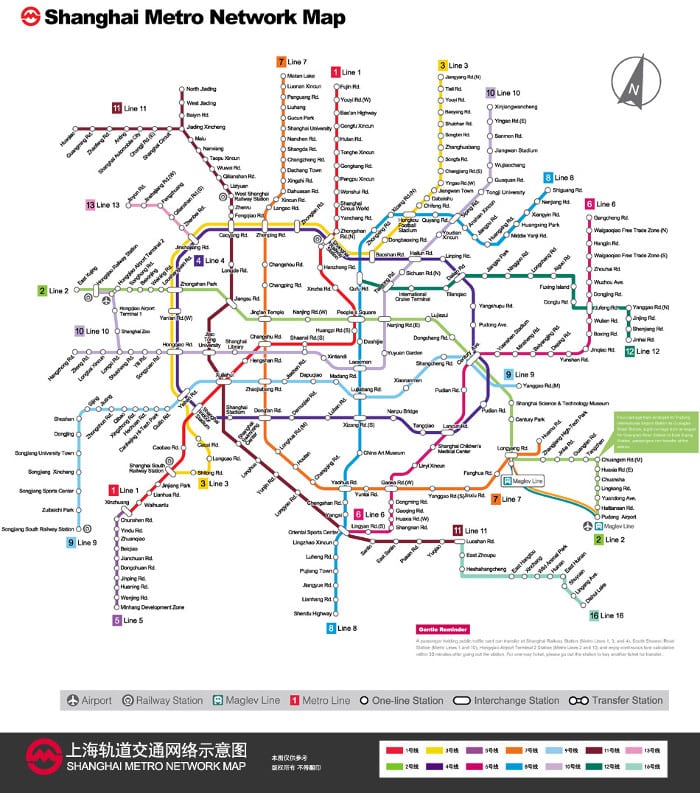
The Shanghai Metro system
The Shanghai Metro system is, currently the most extensive on the planet. On this page, you can find timetables and ticket prices.
Here you’ll find an interactive Metro map offered by ExploreMetro (you can also download the app for iOS).
Shanghai Public Transport Card
If you’re staying in the city for more than two days, I recommend that you get the “Shanghai Public Transport Card (SPTC)” (交通一卡通 or jiaotong yi katong, in Chinese), which you can either pick up or recharge in pretty much all Metro stations as well as many “convenience store” throughout the city. It’s a rechargeable “contact-less” card (similar to the Oyster Card of London).
The initial cost is 20 Yuan (which will be refunded if and when you return the Transport Card). To recharge it, all you have to do is go to any window at the Metro and give your card to the attendant along with the money you want to be applied to your card.
Besides the Metro, the Transport Card can also be used for buses, boats, taxis, tourist attractions, parking lots, service stations, highways, and the Maglev.
Buses in Shanghai
In Shanghai, there are more than 1000 bus lines, run by 10 different bus companies. The most important stations are at the Shanghai Railway Station, Zhongshan Park, People’s Square, Xujiahui, and Shanghai Indoor Stadium. Click here to learn more.
Personally, in Shanghai, I rarely used the buses. The reason is that the metro system is extremely efficient and covers the city very extensively. At night, when the Metro was closed, I walked or took a taxi (which in China are relatively cheap).
Weather in Shanghai
Shanghai has a subtropical climate. The winters are cold and marked by occasional Siberian winds; it’s rare that the temperature drops below zero. In fact, it rarely snows. The summers are hot and humid; it often reaches 35 degrees which, even if it doesn’t seem like much, in a concrete jungle like Shanghai you’ll really feel it. Toward September and October, you can’t exclude the possibility that the city may be in line for a few typhoons. The best seasons are the Spring – though in June the rainy season begins – and the autumn, which instead is the driest season (with temperatures similar to the Spring).

![]() Climate data for Shanghai by Wikimedia Foundation, Inc.
Climate data for Shanghai by Wikimedia Foundation, Inc.
Where to live in Shanghai
Shanghai is divided in two by the Huangpu River, which crosses from North to South. The eastern part, where the city center is, is called Puxi while the western part, where the financial district is located, is called Pudong.
The city is enormous. Before deciding where to live, you should consider your priorities. If you prefer to live close to work (or the university where you study) then search for a house in the area or, if your office/university is in the center and you can’t live there because rents are too high, at the minimum look for a house or room with a Metro stop on the line that has a stop close to your office or school. The same applies if you have kids or prefer living near their school.
If instead you value your social life more, keep in mind that almost all bars and clubs are found inside – or in the surrounding areas – of the French Concession, the heart of Shanghai. That area has, not by chance, one of the highest concentrations of expats (even if families with little children often tend to stay away since schools are scarce).
Considering the way the city is organized, in my opinion, the best choice is to live along Metro Line 2, which cuts across horizontally – starting from Pudong Airport and arriving at Hongqiao Airport, passing through Pudong, including the financial center of the city (the stop is Lu Jia Zhui), and the city center itself.
Next, you’ll find a brief description of the various areas of Shanghai. Here you’ll find our complete guide to finding a house in Shanghai (agencies, contracts, etc).
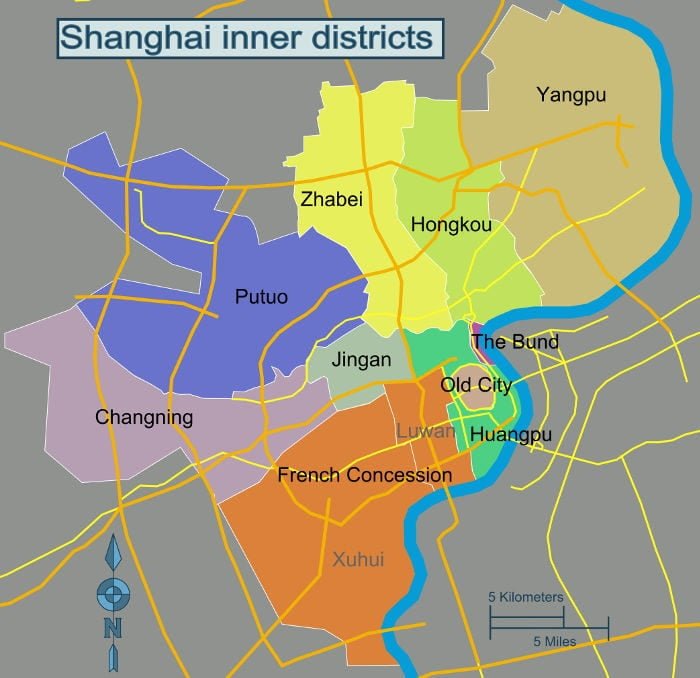 The districts of Shanghai’s city center –
The districts of Shanghai’s city center – ![]() Map by Claus Hansen
Map by Claus Hansen
City Center (Puxi)
While the northern and eastern borders of the city center are well defined by Suzhou Creek and the Huangpu River, you can’t say the same for the eastern and southern ones, which personally I tend to fix along Lines 11 and 9 of the Metro, which run parallel to Huashan Road and Zhaojiaban Road, respectively.
As has already been mentioned, the main advantage of living in the center – especially in Jing’An, that’s a little micro-center in Shanghai, to use a completely Argentinian term – is that you’ll find yourself at the most a 10-15 minute taxi ride to all the main bars and clubs in the city (even if, depending on where you live and the club in question, it’s possible that you can get there on foot in less than 10 minutes).
Aside from the clubs, this is also the area where you’ll find the majority of “foreign” restaurants, theaters and museums.
The cons are that the rents are more expensive, apartments are often in bad shape (their age really shows), traffic pollution is greater and as was already said, if you have young children, there are no international schools.
Other than Jing’An, in the center I have “designated” there’s also the neighborhoods of Huangpu, or the most touristy section of the city, from which you can also admire the skyline of Pudong, the Old French Concession, with its clubs and shopping centers (see the next sections for the details) and the eastern part of Changning, which is likely the most economical place to rent in the center.
Changning and Xuhui (Puxi)
Changning and Xuhui are two residential neighborhoods situated to the west and southwest of the city center respectively.
The eastern part of Changning, Hongqiao, othern than being the home of one of the city’s two airports, also hosts many international companies. This is the reason why so many western familes have chosen to settle here. Not by chance, in this neighborhood there is an ample selection of international schools.
Zhabei and Hongkou (Puxi)
Zhabei and Hongkou are two neighborhoods to the northeast of the city center. You don’t often hear about them since, historically, the concentration of westerners has always been less than the ones already presented.
Recently the the city government has invested a lot to renew these neighborhoods and I have to say, considering the low rents and relatively close location to the city center, it’s an interesting area. So long as you don’t mind being the only westerner in the area!
The financial district of Lujiazui (Pudong)
Lujiazui is in Pudong, in front of the Bund. It is here that the “famous” skyscrapers of Shanghai rise up. You’ll mainly find financial firms, luxury hotels and shopping centers, other than the Pearl Tower.
Despite the fact that the apartments of Lujiazui may be rather luxurious, the prices haven’t yet exploded for the simple fact that because of building speculation, the supply is greater than the demand.
Jinqiao (Pudong)
Jinqiao, like Hongqiao, hosts many foreign companies. This has made it so that even here, in Pudong, an “expat” community has arisen, where you’ll find various international schools, Carrefour, and various taverns (pubs, eccetera) “deigned” for westerners.
Tourism in Shanghai
This article is dedicated to the practical aspects of the city; here you can learn more about the principal tourist attractions of Shanghai.
If instead you’re interested in more general articles about traveling in China, I recommend that you start here.
To finish, here you’ll find our reviews on the best luxury and budget hotels in Shanghai.
Hospitals and clinics in Shanghai
To start off, if you’re thinking about traveling or moving to Asia without an insurance policy, think again. In the event that you have a health problem, no one will take care of you unless you can pay in cash or are covered by a policy. Click here to learn more on the subject.
International clinics in Shanghai
If you want to avoid having to argue in Chinese or winding up in a hospital with health standards that are far lower than those in the west, so I recommend that you choose a hospital or international clinic. Here is a list (which is by no means exhaustive):
Shanghai East International Medical Center
Address: 150, Jimo Road
Telephone: +862158799999
Shanghai United Family Hospital and Clinics
Address: 1139, Xianxia Road
Telephone: +862151331900
SinoUnited Health
Address Jing’an Branch: Suite 601, Shanghai Centre, 1376 West Nanjing Road
Telephone: +862162798920
Address Jinqiao Branch: 16, Lane 300, Hongfeng Road
Telephone: +862150307810
Address Gubei Branch: 491 South Yili Road
Telephone: +862161249979
America-Sino OB/GYN Service
Address: 14F, Complex Building, Huashan Hospital, 12 Middle Urumqi Road
Telephone: +862162493246
Parkway Health and Dental Clinics
Address: 203-4 West Retail Plaza, 1376 Nanjing Xi Road
Telephone: +862164455999
Local hospitals
In “local” hospitals, unless they have a “VIP” clinic (which will obviously be more expensive) forget about them speaking English or taking you in by appointment: you’ll have to wait on line like everyone else and communicate in Chinese. Not all hospitals accept foreigners. Here is a list, not exhaustive, of those that should accept you (but check first):
Shanghai First People’s Hospital International Care Center
Address: 585 Jiulong Road, Shanghai 200080
Telephone: +862163243852
Shanghai Ruijin (Guangci) Hospital
Address: Building 38, 197 Ruijin Er Road
Telephone: +862164664483
Shanghai Huadong Hospital
Address: 221 Yan’an Xi Road
Telephone: +862162483180
Ruidong Hospital
Address:Lane 50, 1507 Loushan Road
Telephone: +862158339595
Ren’ai Hospital
Address: 133 Caoxi Road
Telephone: +862164688888
Shanghai Children’s Medical Center
Address: 1678 Dongfang Road
Telephone: +862138626161
Schools and universities in Shanghai
International schools, private Chinese schools and public Chinese schools
As far as kindergartens, elementary, middle and high schools go, there are three choices. The first is sending your child to a international school. In Shanghai there are ample choices of curriculum to choose from (American, British, French, German, Japanese, Korean and others).
There are many pros for international schools, from better prepared & motivated teachers and classes of 10-20 students; the main drawback is the price, since for tuition we’re talking about figures that come close to or even surpass 15-20,000 USD a year.
This is a choice only for those who have a lot of money or have been hired by a western firm and has a contract that also includes tuition for their kids.
Private Chinese schools are usually cheaper than international schools. Also, students are taught both in Chinese and English. The drawback is that kids are accepted only if they have a “native” Mandarin level, and classes are larger than the classes of international schools (about twenty to thirty kids).
Public schools are free. There are however a few problems. The first is that your child will only be accepted if they have Chinese citizenship. Moreover, in these schools the teaching is mostly in Mandarin (so if you want your child to learn English well they’re not the best), the teaching style is that of the traditional Chinese method (where the “memorization” technique is king, to the loss of creativity), and the classes are much larger (about fifty kids).
To close, to be admitted into a Chinese public school, your child must be a resident in the area where the school is found. This fact has made it so that with time, all these families that have the means have moved near the best schools, thereby raising the price of rents.
Universities
Here are the four main universities of Shanghai:
Founded in 1905, it is one of the most prestigious universities in China. Fudan has four campuses (Handan, Fenglin, Zhangjiang and Jiangwan) and about 31,000 students, with some 3,000 foreigners.
Shanghai Jiao Tong University (上海交通大学)
Founded in 1896, Jiao Tong vies for, year by year, for the the title of “best university” in Shanghai with Fudan. It has about 40,000 students and several campuses, the most important being Xuhui and Minhang.
Founded in 1907, Tongji has two campuses (Siping Road and Jiading) and about 50,000 students.
East China Normal University (华东师范大学)
Founded in 1956, East China Normal has two campuses (Putuo and Minhang) and about 32,000 students.
Click here to see the complete list of universities in Shanghai. Here you’ll find our own advice for studying Chinese in Shanghai.
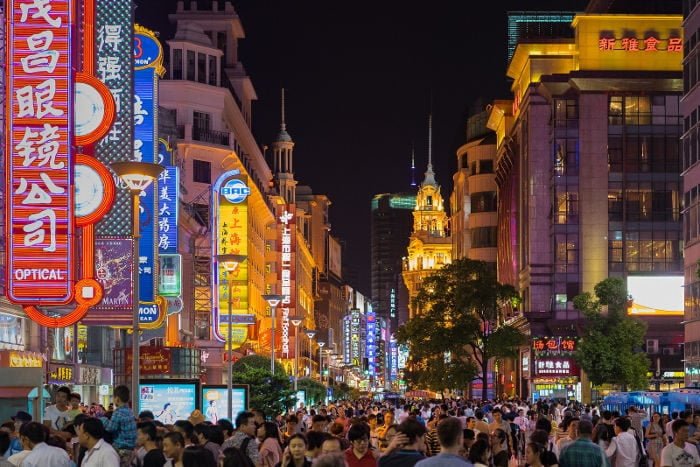
Shopping in Shanghai
If you’d like to buy western brand products, I recommend Carrefour. Here you’ll find a complete list of Carrefours spread around the city, including address and directions as to how to get there. Besides Carrefour, you can find a good selection of imported products also at City Shop or Mark & Spencer (generally, both are more expensive than Carrefour).
Below you’ll find a list of the main shopping centers in Puxi:
Plaza 66
Address: 1266, West Nanjing Road
Store times: 10:00 – 22:00
How to get there: Take Line 2 of the Metro to West Nanjing Road station
Jiu Guang Department Store
Address: 1618, West Nanjing Road
Store times: 10:00 – 22:00
How to get there: Take Line 2 of the Metro to West Nanjing Road station
Shanghai Times Square
Address: 99, Middle Huaihai Road
Store times: 10:00 – 22:00
How to get there: Take Line 8 of the Metro to Dashijie station
Hong Kong Plaza
Address: 282, Middle Huaihai Road
Store times: 10:00 – 22:00
How to get there: Take Line 1 of the Metro to South Huangpi Road station
Grand Gateway
Address: 1, Hongqiao Road
Orari di Apertura: 10:00 – 22:00
How to get there: Take Line 9 of the Metro to Xujiahui station
Here you’ll find a list of shopping centers in Pudong:
Super Brand Mall
Address: 168, Lujiazui Xi Road
Store times: 10:00 – 22:00
How to get there: Take Line 2 of the Metro to Lujiazui station
Shanghai IFC Mall
Address: 8, Century Avenue
Store times: 10:00 – 22:00
How to get there: Take Line 2 of the Metro to Lujiazui station
Times Square
Address: 500, Zhangyang Road
Store times: 10:00 – 22:00
How to get there: Take Line 9 of the Metro to Shangcheng Road station
Useful numbers and addresses in Shanghai
In the event that you lose your passport, need to renew your passport or have some need to contact the your consulate during your stay. Here we only list the general consulate of USA, UK, Australia, Canada, Germany, France and Singapore.
General consulate of the United States of America in Shanghai
Address: 1469 Huaihai Zhong Road (Near Wulumuqi Nan Road)
Telephone: +862162797662
Email: [email protected]
Website: china.usembassy-china.org.cn/embassy-consulates/shanghai/
Office Hours: 8:00-11:30 and 13:30-15:30 (Monday to Friday)
The U.S. Consulate in Shanghai’s consular section is located on the Westgate Mall, 8/F, 1038 West Nanjing Road.
General consulate of the United Kingdom in Shanghai
Address: Suite 319, Shanghai Centre, 1376 Nanjing Xi Road
Telephone: +862132792000
Email: [email protected]
Website: www.gov.uk
Office Hours of Counter Services/Telephone Inquires: 08:30-12:00 and 14:00-16:00 (Monday to Thursday), 08:30-12:00 (Friday)
The consular section only operates by appointment; thus you shall call the office or book an online appointment.
General consulate of Australia in Shanghai
Address: Level 22, CITIC Square, No.1168 Nanjing West Road
Tel: +862152925500
Email: [email protected]
Website: shanghai.china.embassy.gov.au
Office Hours: 8:30 to 17:00 (Monday to Friday)
General consulate of Canada in Shanghai
Address: Suite 604, West Tower, Shanghai Center, No.1376 Nanjing West Road
Tel: +862132792800
Email: [email protected]
Website: www.canadainternational.gc.ca
Office Hours: 9:00 to 11:30 (Monday to Friday)
General consulate of Germany in Shanghai
Address: 181, Yongfu Road
Telephone: +862134010106
E-mail: [email protected]
Office Hours: 08:00-12:00 and 13:00-17:30 (Monday to Thursday), 08:00-12:00 and 12:00-15:00 (Friday)
General consulate of France in Shanghai
Address: 2/F, Haitong Securities Building, No. 689 Guangdong Road
Tel: +862161032200
E-mail: [email protected]
Website: cn.ambafrance.org
Office Hours: 09:00-18:00 (Monday to Friday)
General consulate of Singapore in Shanghai
Address: 89 Wanshan Road
Telephone: +862162785566
E-mail: [email protected]
Website: www.mfa.gov.sg
Office Hours: 08:30-12:00 and 13:00-17:00 (Monday to Friday)
Exit and Entry Administration of Shanghai Public Security Bureau
To extend your visa or renew your permit you’ll have to go to the Exit and Entry Administration of Shanghai Public Security Bureau:
Address: 3rd Floor, 1500, Minsheng Road, Pudong New Area
Telephone: +862128951900
Hours of operation: 9am – 5pm, from Monday and Saturday
Health Center of Shanghai Exit and Entry Inspection & Quarantine Bureau
To change your work or student visa to a resident permit you’ll have to submit to a medical visit at the Health Center of Shanghai Exit and Entry Inspection & Quarantine Bureau:
Address: 15, Jinbang Road
Telephone: +862162682966
Hours of operation: 9am – 11am, from Monday and Friday
Public Security Bureau
To register your address (the procedure its mandatory unless you reside in a hotel), you’ll have to go to the Public Security Bureau in your area (ask for the address from your landlord or the agency that rented your the room/apartment).
Here are a few:
Changning District: 201, Weining Road
Huangpu District: 174, Jinling East Road
Jingan District: 415, Jiaozhou Road
Luwan District: 22 Jianguo Zhong Road
Pudong District: 655, Dingxiang Road
Putuo District: 1895, Daduhe Road
Xuhui District: 901, Tianyaoqiao Road
Yangpu District: 2049, Pingliang Road
Zhabei District: 600, Tianmu Zhong Road
Forums and directories on Shanghai
Smart Shanghai is a mix between a magazine, a directory of resources on the city and a forum. In my opinion the most useful parts are the offers for those looking for a house, local reviews, restaurants and events. eChina Cities is a similar website.
Internations is a great website for those who wish to meet people with interests similar to their own, join events to meet other expatriates living in Shanghai, or finding informations and tips.
MeetUp is a website for those who wish to meet people with interests similar to their own, from tennis to salsa to philosophy.
Frequently asked questions
When it comes to food, a meal in an inexpensive local restaurant costs 5 USD on average, which is not very cheap when comparing to other Asian countries. The cost of having your kids in international schools is another story and many Chinese relocate overseas just for the sake of getting quality education for a significantly lower cost.
Many foreigners are surprised how you can walk through parks in the middle of the night, finding your way back home. Violence and robberies towards foreigners are extremely rare. The only thing you should concern about is tourist scams. Personally, I’ve experienced tourist scams two times at People’s Square (where there are many tourists) and around East Nanjing Road.
Foreigners sometimes get sick after drinking tap water purified by filters. Secondly, there are metals and other toxic substances that some filters cannot remove. My recommendation is to always use bottled water, even when boiling water for tea or coffee for example (the metals will remain in the boiled tap water).
At the moment, the PM2.5 is 156 micrograms, which is way above the World Health Organization’s threshold of 10 micrograms. Use face masks as frequently as you can, and especially if you intend to walk or bicycle longer distances. You can find face masks in convenient stores like 7-Eleven.
Another benefit of living in Hongqiao is that Shanghai Hongqiao Airport is located in the vicinity. Expats with families who don’t live in Hongqiao tend to chose Pudong, that brings some similarities to Hongqiao.
If you live in Pudong, you’ll reach Shanghai Pudong International Airport significantly faster. Young expats who move to China on their own often chose to stay in smaller apartments in more central areas, for example, in Xujiahui, Jingan, or Xuhui.
Photo Credits: ![]() Shanghai Evening by Bernd Thaller
Shanghai Evening by Bernd Thaller
![]() Nanjing Road in Shanghai by Achim Fischer
Nanjing Road in Shanghai by Achim Fischer
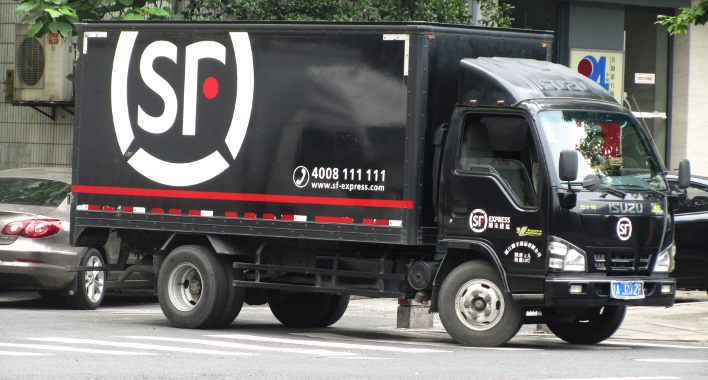
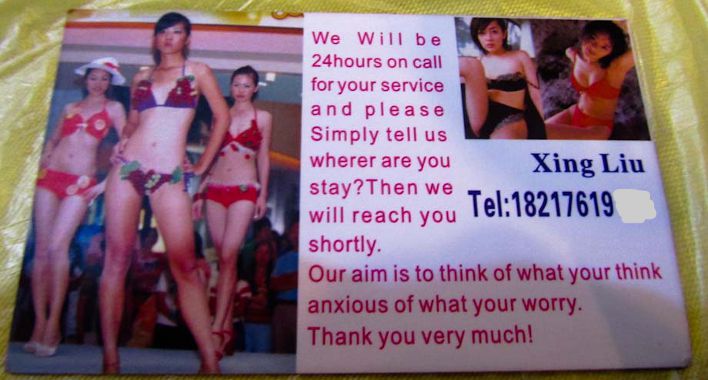
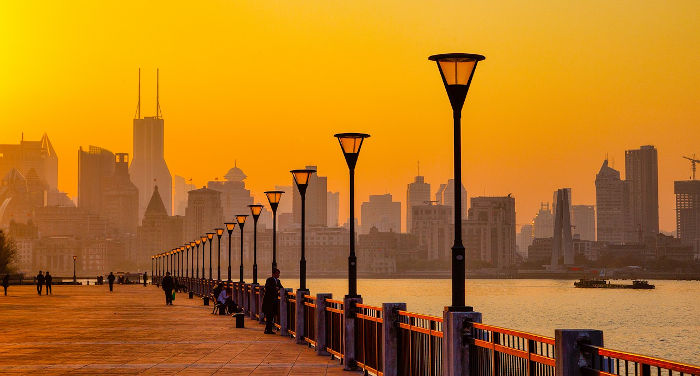

Hi, where do you suggest I should stay? my office at zhangjiang hi-tech park and schools at minhang…
This depends on your lifestyle and how much you want to spend on your rent, but Pudong might be a good option.
Hello! I remember I saw a chart with the data of how expensive is living in Shanghai according to lifestyle and I can’t find it anymore. Could you help me please?
I can see it without a problem, can you tell me what browser are you using? If you are located in China, are you using a VPN?
Hi, what kind of lifestyle can I have with 60,000RMB per month?
Quite high standard lifestyle, few people in Shanghai have this income.
Very informative! Though, do you have any idea how scientists (PostDoctoral research ers) get?
Hello Coy,
it’s a good question, however there is not a good answer as the salaries for postdocs may vary greatly because they will depend on the kind of funding that is sponsoring you (national level, university level, lab level etc).
So, if you are interested on doing a postdoc in China, I suggest you to get in touch with the professor you want to work with, and ask him what kind of funding he can provide.
Wow, so informative! Do you have smth like this about Guangzhou or Shenzhen?
Yes, Guangzhou here and Shenzhen here
Hi, can I survive with 15,000RMB per month living in Shanghai?
Thanks.
Yes, although you won’t afford much luxury.
Thanks. May move to Shanghai soon. Get offer from MNC there.
Just one word: wow!
: )